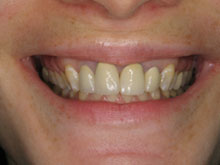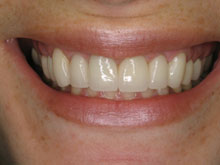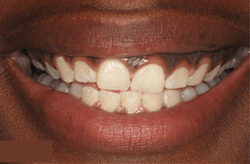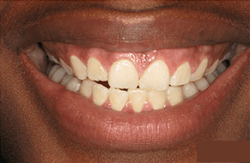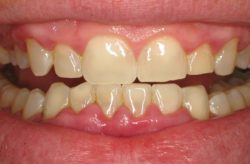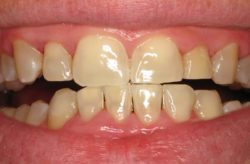Laser Gum Depigmentation For Improved Aesthetics
Understanding Gum Pigmentation
Gum pigmentation, or gum discoloration, is a common aesthetic concern affecting many individuals. The coloration of your gums is primarily determined by the amount of melanin present in the tissues. While naturally pink gums are considered healthy and visually appealing, excessive melanin production can lead to darker pigmentation, making the gums appear brown, black, or blotchy.
Factors such as genetics, hormonal changes, certain medications, and lifestyle habits can contribute to gum pigmentation. Fortunately, advancements in dental technology have led to the development of innovative treatments like laser gum depigmentation, offering a safe and effective solution to enhance the aesthetics of your smile.
Causes and Risk Factors for Gum Pigmentation
Gum pigmentation can be attributed to a variety of causes and risk factors. Some of the most common factors that contribute to the development of gum discoloration include:
- Genetics. Genetic factors play a significant role in determining the natural pigmentation of an individual’s gums. Some people are genetically predisposed to having darker gums, which can manifest as excessive pigmentation.
- Ethnicity. Certain ethnic groups, such as individuals of African, Asian, or Native American descent, have a higher likelihood of having naturally darker gums.
- Hormonal Changes. Hormonal fluctuations, particularly during pregnancy, can lead to an increase in melanin production. This hormonal imbalance can result in gum pigmentation.
- Medications. Certain medications, such as antimalarial drugs, minocycline (an antibiotic), and certain anti-seizure medications, have been associated with gum discoloration as a side effect.
- Smoking. Smoking tobacco products can cause various oral health issues, including gum pigmentation. The chemicals in tobacco smoke can lead to changes in the gum tissue, causing it to darken over time.
- Systemic Diseases. Certain medical conditions, such as Addison’s disease, Peutz-Jeghers syndrome, or hormonal imbalances, can contribute to gum pigmentation.
- Poor Oral Hygiene. Inadequate oral hygiene practices can result in the buildup of plaque and tartar on the gum line. This can lead to inflammation and an increased likelihood of gum discoloration.
While gum pigmentation is typically harmless, it can impact a person’s self-esteem and confidence. If you are concerned about gum pigmentation, call (877) 440-3564 to consult with one of our dental professionals. We can evaluate your specific situation and recommend appropriate treatment options.
Impact of Gum Pigmentation on Aesthetic Appearance
Gum pigmentation can significantly impact the aesthetic appearance of an individual’s smile. The natural color of the gums is typically pink or coral, which creates a visually pleasing contrast against the teeth. However, when excessive pigmentation occurs, the gums appear dark, blotchy, or discolored. This can create an imbalance in the overall aesthetics of the smile and affect one’s self-confidence.
The presence of gum discoloration can draw attention away from the teeth and become a focal point during social interactions or when smiling. Individuals with gum pigmentation may feel self-conscious or embarrassed about their oral appearance, leading to reluctance to smile or laugh openly. This can have a negative impact on their social interactions, professional image, and overall quality of life.
Furthermore, gum pigmentation can sometimes make the teeth appear shorter or smaller as the darkened gums encroach upon the visible tooth surface. This can alter the perception of tooth proportions and affect the overall harmony of the smile.
Fortunately, with advancements in dental technology, treatments such as laser gum depigmentation are available to address gum pigmentation concerns and enhance smile aesthetics. By reducing or eliminating excessive melanin, these procedures can help restore the natural pink appearance of the gums, creating a harmonious and aesthetically-pleasing smile.
Laser Gum Depigmentation: An Overview
Definition and Purpose of Laser Gum Depigmentation
Laser gum depigmentation is a cosmetic dental procedure that aims to reduce or eliminate excessive pigmentation or discoloration of the gums. This treatment involves using a dental laser to target and remove the melanin pigments responsible for the darkened appearance of the gums.
The purpose of laser gum depigmentation is primarily aesthetic. It is performed to improve the smile’s overall appearance by creating a more uniform and pleasing gum coloration. Laser gum depigmentation can enhance smile aesthetics, boost self-confidence, and contribute to a more attractive oral appearance by reducing the dark patches or spots on the gums.
An experienced dentist or periodontist performs the procedure. It involves directing a specialized laser onto the pigmented areas of the gums, which selectively absorbs and removes the excess melanin. The laser energy gently targets and breaks down the pigment without causing significant damage to the surrounding tissues.
History and Development of Laser Gum Depigmentation
The history and development of laser gum depigmentation can be traced back to the advancements in laser technology and its applications in dentistry. The use of lasers in dentistry gained traction in the 1960s with the introduction of ruby lasers. As technology progressed, different types of lasers, such as a diode, erbium:yttrium-aluminum-garnet (Er:YAG), and carbon dioxide (CO2) lasers, were developed and found applications in various dental procedures.
In the late 1980s and early 1990s, researchers and dental professionals began exploring the use of lasers for gum depigmentation. Initially, the focus was on treating localized hyperpigmentation using different laser wavelengths and energy settings. The introduction of the neodymium-doped yttrium-aluminum-garnet (Nd:YAG) laser was a significant milestone in laser depigmentation. This Nd:YAG laser effectively targeted melanin pigments in the gums while minimizing damage to the surrounding tissues. It offered better control and precision and reduced the risk of complications compared to earlier laser systems.
Over time, dental professionals refined the laser gum depigmentation techniques, optimizing laser parameters such as wavelength, pulse duration, and energy levels. This allowed for more predictable results: improved patient comfort and enhanced post-treatment healing. As laser technology continued to advance, newer generations of lasers, such as the diode and erbium lasers, were introduced with specific benefits for gum depigmentation procedures. These lasers offered better absorption by melanin, increased efficiency, and improved patient experience.
Today, laser gum depigmentation has become a well-established procedure in cosmetic dentistry. Dental professionals with expertise in laser technology and aesthetics perform this treatment using advanced laser systems designed explicitly for gum depigmentation. Ongoing research and advancements in laser technology continue to refine and improve the outcomes and patient experience associated with laser gum depigmentation.
Role of Laser Gum Depigmentation in Cosmetic Dentistry
Laser gum depigmentation plays a crucial role in cosmetic dentistry by addressing the aesthetic concerns associated with gum pigmentation. Some of the critical aspects of its role include:
- Enhancing Smile Aesthetics. Excessive gum pigmentation can create an imbalance in the appearance of the smile. Laser gum depigmentation helps to restore s more uniform and pleasing gum color, enhancing the overall aesthetics of the smile. This procedure creates a more balanced smile by reducing or eliminating dark patches or spots on the gums.
- Boosting Self-Confidence. The appearance of darkened gums can cause self-consciousness and impact an individual’s self-confidence. Laser gum depigmentation can significantly improve the patient’s confidence in their smile, encouraging them to smile more freely and feel more comfortable in social and professional interactions.
- Personalized Treatment. Laser gum depigmentation allows for precise control and customization of the treatment. Our dental professionals can tailor the procedure to patients’ needs and preferences. This personalized approach ensures the results are natural-looking and align with the patient’s desired outcome.
- Minimally Invasive Procedure. Laser gum depigmentation is a minimally invasive procedure with several advantages over traditional surgical methods. It involves minimal discomfort, reduced bleeding, and faster healing than conventional gum depigmentation techniques. The precise nature of lasers allows for targeted treatment, minimizing damage to the surrounding tissues.
- Predictable and Consistent Results. Laser technology enables dental professionals to achieve predictable and consistent results in gum depigmentation. The controlled energy delivery and selectivity in targeting melanin pigments ensure that the procedure effectively removes or reduces excessive pigmentation while preserving the health and integrity of the gums.
- Safe and Efficient Treatment. Laser gum depigmentation is a safe and effective treatment option. Using lasers minimizes the risk of infection and complications during and after the procedure. Additionally, the procedure can be performed relatively quickly, reducing the overall treatment duration and enhancing patient convenience.
Laser gum depigmentation plays a vital role in cosmetic dentistry by improving smile aesthetics, boosting self-confidence, providing personalized treatment, and offering a safe and efficient solution for individuals with gum pigmentation concerns. Its minimally invasive nature, and predictable outcomes make it a valuable tool for dental professionals to achieve desirable cosmetic results and enhance patient satisfaction.
The Laser Gum Depigmentation Procedure
Preparing for Laser Gum Depigmentation
Preparing for laser gum depigmentation is essential to ensure a smooth and successful procedure. Here are some important steps to take before undergoing laser gum depigmentation:
- Consultation with a Dental Professional. Schedule an initial consultation with one of our qualified dental professionals experienced in laser gum depigmentation. During this appointment, we will evaluate your oral health, discuss your expectations, explain the procedure, and determine if you are a suitable candidate for laser gum depigmentation—call (877) 440-3564 to schedule your appointment.
- Medical History and Medications. Inform your specialist about your complete medical history, including any medications, allergies, or underlying health conditions. Some medications, such as blood thinners, may need to be adjusted before the procedure to minimize bleeding risks.
- Oral Hygiene. Maintain good oral hygiene leading up to the procedure. Brush your teeth thoroughly at least twice daily and floss regularly to ensure a clean and healthy oral environment. This helps minimize the infection risk and promotes faster healing after the procedure.
- Avoid Smoking. Smoking can interfere with the healing process and increase the risk of complications. If you smoke, quitting or avoiding tobacco before and after the procedure is advisable.
- Avoid Staining Substances. Refrain from consuming staining substances such as coffee, tea, red wine, or tobacco products in the days leading up to the procedure. These substances can affect the outcome of the depigmentation treatment.
- Follow Pre-Procedure Instructions. Your dental professional will provide specific instructions before the laser gum depigmentation procedure. This may include fasting before the appointment if anesthesia is required or other particular guidelines to ensure optimal treatment outcomes.
- Arrange Transportation. Laser gum depigmentation is typically performed under local anesthesia. If sedation or anesthesia is used, make arrangements for someone to drive you home after the procedure, as you may feel dizzy or unable to operate a vehicle immediately afterward.
- Ask Questions. If you have any concerns or questions about the procedure, don’t hesitate to ask one of our dental professionals. Understanding the process and having realistic expectations will help you feel more comfortable and confident about undergoing laser gum depigmentation.
By following these preparatory steps and adhering to the specialist’s instructions, you can ensure that you are well-prepared for laser gum depigmentation and increase the chances of achieving optimal results.
Step-by-Step Guide to the Laser Gum Depigmentation Procedure
It’s important to note that the specific steps and details of the laser gum depigmentation procedure may vary based on the individual case and the preferences of the dental professional. It is advisable to consult with your periodontist to understand the process and what to expect in your specific situation. The step-by-step guide to the laser gum depigmentation procedure includes the following:
- Anesthesia. The procedure typically begins with administering local anesthesia to numb the gums and ensure your comfort throughout the treatment. We also offer additional sedation options if needed.
- Preparing the Treatment Area. Our specialists will isolate the treatment area by placing a dental dam or using a retraction cord to protect the surrounding tissues and ensure a clean working environment.
- Laser Application. Our periodontists will use a specialized dental laser, such as a diode laser or an Nd:YAG laser, to target the pigmented areas of the gums. The laser emits a precise beam of light absorbed by the melanin pigments, causing them to break down and disperse.
- Melanin Removal. The laser energy selectively removes or lightens the excessive pigmentation while minimizing damage to the surrounding healthy gum tissue. We will carefully move the laser over the pigmented areas, ensuring that all targeted areas are treated evenly.
- Evaluation and Fine-Tuning. Once the initial laser application is complete, our specialists will evaluate the treated areas and make any necessary adjustments. This may involve additional laser passes to achieve the desired depigmentation results.
- Post-Treatment Care. We will provide specific post-treatment care instructions after the laser gum depigmentation procedure. This may include oral hygiene recommendations, dietary restrictions, and medications to aid in the healing process. It is essential to follow these instructions carefully to promote proper healing and reduce the risk of complications.
Post-Procedure Care and Recovery from Laser Gum Depigmentation
Post-procedure care and the recovery process for laser gum depigmentation are essential for optimal healing and successful results. We provide our patients with a detailed instruction list following the procedure to ensure they are fully aware of what needs to be done. Some of the essential guidelines we advise our patients to follow include:
- Avoid Touching or Disturbing the Treated Area: After the procedure, avoiding touching the treated gums with your fingers or any objects, such as toothpicks or straws, is important.
- Gentle Oral Hygiene: Maintain good oral hygiene, but be gentle around the treated area. Only brush and floss the untreated area of your mouth. Brush your teeth carefully with a soft-bristle toothbrush, using gentle circular motions. Avoid aggressive brushing or flossing near the treated gums to prevent discomfort or damage. Do not brush or floss the treated area until directed by the doctor at your follow up visits.
- Use a Mild Mouthwash: Rinse your mouth with a mild, non-alcoholic mouthwash as your dental professional recommends. This helps to maintain oral hygiene and promote a healthy healing environment. Avoid using mouthwashes that contain alcohol, as they can irritate the treated area.
- Cold Compresses for Swelling: If you experience swelling or discomfort, apply cold compresses or ice packs wrapped in a cloth to the outside of your face. This can help reduce swelling and alleviate pain. Apply the cold compresses for 15 minutes, with breaks in between.
- Follow Medication Instructions: If your dental professional prescribes any medications, such as pain relievers or antibiotics, take them as directed. Follow the recommended dosage and complete the entire course of antibiotics if prescribed. This helps prevent infection and manage any discomfort.
- Avoid Smoking and Tobacco Products: Refrain from smoking or using tobacco products during recovery. Smoking can impede the healing process and increase the risk of complications. Avoiding these habits for as long as possible after the procedure is best.
- Follow a Soft Diet: Stick to a soft diet for a few days following the procedure. Choose foods that are easy to chew and won’t irritate the treated area. Avoid hot, spicy, or acidic foods that may cause discomfort or irritation.
- Follow-Up Appointments: Depending on the case, your specialist may schedule follow-up appointments to monitor your progress and ensure the success of the treatment. These appointments allow our specialists to assess healing, address concerns, polish the teeth, provide cleanings, and provide further guidance on maintaining your gum health and aesthetics.
- Be Patient: Allow your gums sufficient time to heal and avoid expecting immediate results. Healing times can vary from person to person, but it typically takes a few days to a couple of weeks for the gums to fully heal and for any discomfort or swelling to subside.
If you experience severe pain, excessive bleeding, worsening swelling, or other concerning symptoms, contact us immediately at (877) 440-3564. Following these post-procedure care instructions and seeking professional guidance will help ensure a smooth recovery and enhance the long-term outcomes of your laser gum depigmentation procedure.
Benefits of Laser Gum Depigmentation
Laser gum depigmentation offers several benefits for individuals seeking to enhance the aesthetic appearance of their gums. Firstly, it provides an exact and controlled treatment approach. The focused laser energy selectively targets and breaks down the excess melanin pigments responsible for gum pigmentation while minimizing damage to the surrounding healthy tissue. This precision allows for predictable and consistent results, ensuring a more uniform and pleasing gum color.
Secondly, laser gum depigmentation is a minimally invasive procedure. Laser treatment involves minimal discomfort, reduced bleeding, and faster healing than traditional surgical methods. The procedure’s non-invasive nature means there is no need for sutures or incisions, resulting in less post-operative pain and a quicker recovery.
Furthermore, laser gum depigmentation offers improved patient comfort and convenience. The procedure can often be performed in a single visit, reducing the required appointments. Local anesthesia is typically sufficient to numb the area, allowing patients to remain awake and comfortable throughout the treatment. Additionally, the precise nature of laser technology minimizes the need for extensive touch-ups or retreatment.
Another advantage of laser gum depigmentation is its ability to achieve natural-looking results. Our specialists can precisely control the degree of depigmentation to match the patient’s desired outcome by carefully adjusting the laser settings. This customization ensures that the results appear natural and harmonious with the rest of the smile, enhancing overall facial aesthetics.
This treatment offers long-lasting outcomes. Once the excess pigmentation is removed, the results can be permanent. However, it’s important to note that maintaining good oral hygiene practices, avoiding known pigment-inducing factors, and regular dental check-ups are crucial for sustaining the results over time.
Success Rate and Long-Term Efficacy of Laser Gum Depigmentation
The success rate and long-term efficacy of laser gum depigmentation are generally high. However, it is essential to note that individual results can vary depending on several factors, including the extent of pigmentation, the patient’s oral hygiene habits, lifestyle choices, and overall oral health.
Laser gum depigmentation has shown a high success rate in effectively reducing or eliminating excess pigmentation on the gums. The procedure’s success largely depends on the skill and experience of the dental professional performing the treatment. Our skilled professionals have years of experience in laser technology and have transformed many smiles with laser gum depigmentation.
In terms of long-term efficacy, laser gum depigmentation can provide beautiful results. Once the excess pigmentation is removed, the treated areas typically maintain their improved appearance for a significant period. However, it’s important to note that maintaining good oral hygiene practices and avoiding lifestyle factors that contribute to gum pigmentation, such as smoking or certain medications, are crucial in preserving the results over time.
While laser gum depigmentation can offer long-term efficacy, it’s essential to understand that the gums may still be susceptible to natural changes and aging. Over time, the gums may undergo slight color variations or develop new pigmented areas due to genetics, hormonal changes, or certain medications. Regular dental check-ups and good oral hygiene are essential for long-term results.
It is worth mentioning that various factors can influence the success rate and long-term efficacy of laser gum depigmentation. These include the patient’s commitment to oral hygiene, lifestyle choices, and adherence to post-procedure care instructions. It is crucial to consult with a qualified dentist or periodontist who can assess your specific case, provide appropriate treatment recommendations, and guide you on the expected outcomes and long-term maintenance of the results.
Impact of Laser Gum Depigmentation on Smile Aesthetics
Laser gum depigmentation significantly impacts smile aesthetics by improving the appearance of the gums. Some of how laser gum depigmentation can enhance smile aesthetics are:
- Gum Color Harmony. Excessive gum pigmentation or dark spots on the gums can create an uneven or unbalanced smile appearance. Laser gum depigmentation helps to make a more harmonious and balanced smile by removing the excess pigmentation and creating a more uniform gum color. This can result in a more aesthetically pleasing smile overall.
- Symmetry and Proportions. Laser gum depigmentation can help achieve better symmetry and proportions in the smile. Uneven gum pigmentation can make the teeth appear shorter or smaller than they are, affecting the overall balance of the smile. Laser gum depigmentation can create a more proportional and balanced smile by addressing the pigmented areas, allowing the teeth to appear longer and proportioned.
- Frame the Teeth. The gums act as a frame for the teeth, and their appearance significantly impacts the overall smile aesthetics. Laser gum depigmentation can improve the structure by creating a more even and natural-looking gum line. This can help showcase the teeth and shape, resulting in a more attractive and confident smile.
- Brighter Smile. Dark or discolored gums can create the illusion of a darker smile. Laser gum depigmentation can help brighten the smile by removing the darker pigments and revealing lighter, healthier-looking gums. This contrast between the teeth and gums can make the teeth appear whiter and enhance the overall brightness of the smile.
- Boosted Self-Confidence. When individuals feel more confident about their smiles, they are more likely to express themselves freely, engage in social interactions, and display a positive self-image. Aesthetic improvements in the gums through laser gum depigmentation can positively impact an individual’s self-confidence.
If you are considering laser gums depigmentation for smile enhancement, consult one of our experienced specialists by calling (877) 440-3564. Our specialists provide valuable guidance on the potential impact specific to your case and desired aesthetic goals.
Potential Risks and Complications of Laser Gum Depigmentation
While gum depigmentation is generally considered a safe procedure, there are potential risks and complications that individuals should be aware of. These include:
- Gum Sensitivity: Some patients may experience temporary gum sensitivity following laser gum depigmentation. This sensitivity can cause discomfort or mild pain when consuming hot or cold foods and beverages. However, it usually resolves independently within a few days to weeks.
- Gum Irritation or Swelling: It is common to experience mild gum irritation or swelling after laser gum depigmentation. This is typically temporary and should subside within a few days. However, in rare cases, excessive swelling or prolonged irritation may occur, requiring further evaluation by a dental professional.
- Infection: While the risk of infection is minimal, there is still a slight possibility of developing an infection after the procedure. If any signs of infection, such as increased pain, redness, or pus formation, occur, it is vital to contact a dental professional promptly. Following proper oral hygiene practices, adhering to post-operative care instructions, and attending follow-up appointments can help reduce the risk of infections.
- Gum Recession: In some cases, laser gum pigmentation may result in minor gum recession. This occurs when the treated gum tissue pulls back slightly, exposing a small portion of the tooth roots. Gum recession is usually minimal and does not cause significant functional or aesthetic concerns. However, individuals with a history of gum recession may be at a slightly higher risk.
- Uneven Gum Coloration: While laser gum depigmentation aims to create a more uniform gum color, slight color variations or inconsistent results are possible. This can occur due to variations in natural pigmentation, healing response, or individual gum characteristics. Our experienced dental professionals can minimize the risk of uneven coloration and strive to achieve the most balanced results.
It is important to note that the risks and complications associated with laser gum depigmentation are generally rare and often temporary. By choosing a qualified dental professional, following pre-and post-operative care instructions, and maintaining good oral hygiene, the likelihood of experiencing these complications can be significantly reduced.
Common Side Effects and Their Management
Common side effects of laser gum depigmentation may include gum sensitivity, gum irritation, and swelling. Some management strategies for these side effects include:
Gum Sensitivity:
- Use a soft-bristled toothbrush: Switch to a soft-bristled toothbrush to minimize gum irritation and sensitivity during brushing.
- Use a desensitizing toothpaste: Use a desensitizing toothpaste containing ingredients like potassium nitrate or fluoride to help alleviate gum sensitivity.
- Avoid extreme temperatures: Avoid consuming very hot or cold foods and beverages to minimize gum sensitivity.
- Rinse with a saltwater solution: Gently rinse your mouth with a warm saltwater solution (½ teaspoon of salt dissolved in 8 ounces of water) to soothe the gums and promote healing.
Gum Irritation or Swelling:
- Apply a cold compress: If you experience gum irritation or swelling, apply a cold compress to the affected area for 10-15 minutes to reduce inflammation.
- Follow post-operative care instructions: Strictly adhere to the post-operative care instructions provided by your dental professional, including any prescribed medications or mouth rinses.
- Avoid irritating foods: Avoid consuming spicy or acidic foods that further irritate the gums during healing.
- Gentle oral hygiene practices: Continue practicing good oral hygiene, but be gentle while brushing and flossing around the treated area to avoid further irritation.
It’s important to note that these side effects are typically temporary and should resolve within a few days to weeks. However, if the side effects persist or worsen, call (877) 440-3564 for further evaluation and guidance by one of our dental professionals.
Candidacy for Laser Gum Depigmentation
Determining candidacy for laser gum depigmentation is vital in considering this cosmetic dental procedure. While the treatment can benefit many individuals, only some may be suitable candidates. Factors such as the extent of pigmentation, overall oral health, gum health, and individual expectations play a role in determining candidacy. During a comprehensive consultation with one of our qualified dental professionals, we will assess your specific case, discuss your goals, evaluate your oral health, and determine whether laser gum depigmentation is the right option for you.
Ideal Candidates for Laser Gum Depigmentation
Ideal candidates for laser gum depigmentation typically include individuals who meet the following criteria:
- Excessive Gum Pigmentation: Ideal candidates have excessive pigmentation on their gums, affecting their smile’s overall aesthetic appearance. This may include dark spots, uneven pigmentation, or a darker gum color they wish to improve.
- Good Oral Health: Candidates should have good oral health, including healthy gums and teeth. It’s essential to address any underlying oral health issues, such as gum disease or tooth decay, before undergoing laser gum depigmentation.
- Realistic Expectation: Ideal candidates have realistic expectations about the potential outcomes of laser gum depigmentation. They understand that the procedure aims to improve the appearance of the gums but may need to achieve perfection or completely alter their natural gum color.
- Commitment to Oral Hygiene: Candidates should maintain good oral hygiene practices before and after the procedure. This includes regular brushing, flossing, and attending routine dental check-ups to ensure the long-term success of the treatment.
- Non-Smokers: Smoking is a known risk factor for gum pigmentation and can hinder the results of laser gum depigmentation. Ideal candidates are non-smokers or willing to quit smoking to improve their gums’ overall health and appearance.
Limitations and Contraindications of Laser Gum Depigmentation
While laser gum depigmentation is a commonly performed procedure with favorable outcomes, some limitations and contraindications should be considered. First, individuals with thin gum tissue may have regulations in achieving optimal results due to a lack of adequate tissue thickness.
Additionally, individuals with severe gum disease, such as advanced periodontitis, may not be suitable candidates for laser gum depigmentation. Addressing any underlying gum disease or oral health issues is crucial before considering the procedure. Active oral infections or diseases are contraindications for the procedure as they can increase the risk of complications.
Pregnant individuals are generally advised to avoid elective dental procedures, including laser gum depigmentation, due to the potential risks associated with hormonal changes. Certain medications that affect gum health and pigmentation may also impact candidacy.
Lastly, individuals should have realistic expectations about the procedure’s outcomes, as laser gum depigmentation may not completely alter the natural gum color or achieve perfection.
Costs and Considerations for Laser Gum Depigmentation
When considering laser gum depigmentation, there are various costs and considerations. The cost of laser gum depigmentation typically includes the professional fees charged by the dental provider performing the procedure. The fees can vary based on the dentist’s expertise, location, and the case’s complexity.
The complexity of the case and the extent of gum pigmentation can influence the cost. More extensive pigmentation requiring more prolonged treatment and multiple sessions may result in higher fees. In some cases, laser gum depigmentation may be performed with other dental procedures, such as gum contouring or cosmetic dental treatments like veneers or teeth whitening. These additional treatments will have different costs associated with them.
Laser gum depigmentation is primarily considered a cosmetic dental procedure to improve aesthetics. As such, it may not be covered by dental insurance plans. However, it’s worth checking with your insurance provider to determine whether coverage or reimbursement options are available.
Comparative Costs: Laser Gum Depigmentation vs. Other Aesthetic Treatments
When comparing the costs of laser gum depigmentation to other aesthetic dental treatments, it’s essential to consider the specific procedures involved and the complexity of each case. Here is a general overview of the comparative costs of laser gum depigmentation with some common aesthetic treatments:
- Teeth Whitening: Teeth whitening procedures aim to lighten the shade of the teeth and enhance their appearance. The cost of teeth whitening can vary depending on the method used, such as in-office professional whitening or take-home kits. In general, teeth whitening tends to be less expensive than laser gum depigmentation.
- Dental Veneers: Dental veneers are thin shells of porcelain or composite resin bonded to the teeth’ front surface to improve their shape, size, and color. Veneers are custom-made and can be more expensive than laser gum depigmentation, as they require laboratory fabrication and individualized tooth preparation.
- Dental Bonding: Dental bonding involves applying tooth-colored composite resin to the teeth to improve their appearance by covering minor imperfections, such as chips, cracks, or gaps. Dental bonding is typically less expensive than laser gum depigmentation.
- Orthodontic Treatments: Orthodontic treatments, such as braces or clear aligners, straighten crooked or misaligned teeth. The cost of orthodontic treatments can vary widely depending on the case’s complexity, the treatment duration, and the type of braces or aligners used. Orthodontic treatments are generally more expensive than laser gum depigmentation.
- Dental Implants: Dental implants are a permanent solution for replacing missing teeth. They involve surgically placing a titanium implant into the jawbone and attaching a dental crown. Dental implant procedures are typically more costly than laser gum depigmentation due to the surgical component and the materials involved.
It’s important to note that these are general cost comparisons, and actual prices may vary depending on various factors such as location, the expertise of the dental professional, and specific treatment requirements. Consulting with a dental professional will give you a more accurate understanding of the costs associated with the different aesthetic dental treatments based on your individual needs and goals.
Choosing the Right Dental Professional for Laser Gum Depigmentation
Choosing the proper dental practice for laser gum depigmentation is a crucial decision that can significantly impact the success and satisfaction of the procedure. Our practice boasts a team of highly skilled and experienced dental professionals who specialize in laser gum depigmentation and cosmetic dentistry. We have extensive knowledge and expertise in performing the procedure, ensuring patients receive high-quality care and optimal results.
We are committed to utilizing the latest advancements in dental technology, including advanced laser systems designed explicitly for gum depigmentation. We can provide precise and effective treatments by incorporating state-of-the-art equipment and techniques while minimizing discomfort and reducing healing time.
We believe in delivering personalized care to each patient. Our dental professionals take the time to thoroughly assess patients’ specific needs, evaluate their oral health, and understand their aesthetic goals. This enables us to create customized treatment plans tailored to each individual, ensuring the best possible outcomes.
Our practice offers a comprehensive range of dental services, including laser gum depigmentation, LANAP laser gum treatment, gummy smile correction, and more. This allows us to address various aesthetic concerns and provide comprehensive treatment options to help patients achieve their desired smile aesthetics.
We prioritize patient comfort and provide a welcoming and supportive environment. Our team strives to ensure patients feel relaxed and at ease throughout treatment. We take the time to address any concerns or questions, and we provide detailed post-operative care instructions to promote a smooth recovery.
We take pride in the satisfaction of our patients. Through our commitment to delivering exceptional results and excellent patient care, we have built a reputation for positive experiences and successful outcomes. We encourage prospective patients to read testimonials or seek referrals to gain confidence in our practice.
Choosing our practice for laser gum depigmentation means entrusting your smile to a team of dedicated professionals who prioritize your oral health and aesthetic goals. We strive to exceed expectations, provide exceptional care, and help patients achieve beautiful, harmonious smiles through laser gum depigmentation. Call (877) 440-3564 to schedule your appointment today!
FAQ
1. What is laser gum depigmentation?
Laser gum depigmentation is a cosmetic dental procedure that uses laser technology to remove excess pigmentation from the gums, improving their appearance and creating a more aesthetically pleasing smile.
2. Is laser gum depigmentation painful?
Laser gum depigmentation is a minimally invasive procedure performed under local anesthesia, ensuring patient comfort. Most individuals report minimal discomfort during and after the procedure.
3. How long does the laser gum depigmentation procedure take?
The duration of the procedure depends on the extent of pigmentation and the individual case. On average, laser gum depigmentation can be completed in one to two hours.
4. What is the recovery time after laser gum depigmentation?
The recovery time is relatively short for most patients. You may experience mild discomfort and gum sensitivity for a few days, but it typically subsides within a week. Normal activities can usually be resumed immediately after the procedure.
5. Are the results of laser gum depigmentation permanent?
Yes, the results of laser gum depigmentation are generally long-lasting. However, it is important to maintain good oral hygiene practices and attend regular dental check-ups to ensure the longevity of the results.
6. Are there any side effects or risks associated with laser gum depigmentation?
Laser gum depigmentation is a safe procedure with minimal risks. However, some individuals may experience temporary gum sensitivity, swelling, or discoloration, which typically resolves within a few days.
7. Can laser gum depigmentation be performed on any gum color?
Laser gum depigmentation is most effective in addressing excessive pigmentation, such as dark spots or uneven coloration. However, it may not be suitable for individuals who desire a significant change in their natural gum color.
8. Can laser gum depigmentation be combined with other cosmetic dental procedures?
Yes, laser gum depigmentation can be combined with other cosmetic dental treatments, such as teeth whitening or dental veneers, to achieve an overall improved smile aesthetic.
9. How much does laser gum depigmentation cost?
The cost of laser gum depigmentation varies depending on factors such as the extent of pigmentation, location, and the dental professional’s expertise. It is best to consult your dentist for an accurate cost estimate.
10. Am I a suitable candidate for laser gum depigmentation?
Candidacy for laser gum depigmentation depends on factors such as the extent of pigmentation, overall oral health, and individual expectations. Consulting with a qualified dental professional will help determine if you are a suitable candidate for the procedure based on your specific case.

